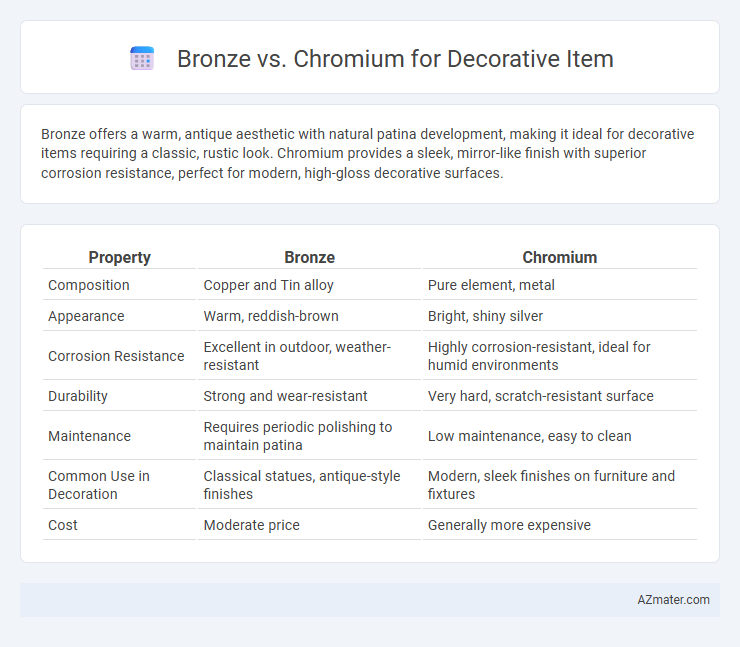Bronze offers a warm, antique aesthetic with natural patina development, making it ideal for decorative items requiring a classic, rustic look. Chromium provides a sleek, mirror-like finish with superior corrosion resistance, perfect for modern, high-gloss decorative surfaces.
Table of Comparison
| Property | Bronze | Chromium |
|---|---|---|
| Composition | Copper and Tin alloy | Pure element, metal |
| Appearance | Warm, reddish-brown | Bright, shiny silver |
| Corrosion Resistance | Excellent in outdoor, weather-resistant | Highly corrosion-resistant, ideal for humid environments |
| Durability | Strong and wear-resistant | Very hard, scratch-resistant surface |
| Maintenance | Requires periodic polishing to maintain patina | Low maintenance, easy to clean |
| Common Use in Decoration | Classical statues, antique-style finishes | Modern, sleek finishes on furniture and fixtures |
| Cost | Moderate price | Generally more expensive |
Introduction to Bronze and Chromium in Decorative Items
Bronze, an alloy primarily composed of copper and tin, is prized in decorative items for its warm, rich patina and excellent corrosion resistance. Chromium, a hard, lustrous metal often used as a plating material, offers a sleek, reflective finish that enhances durability and resists tarnishing. Both materials serve distinct aesthetic and functional purposes in decorative design, with bronze emphasizing classical elegance and chromium delivering modern, high-shine appeal.
Historical Use of Bronze and Chromium in Decor
Bronze has been historically favored in decorative items for its durability and warm, rich patina that develops over time, dating back to ancient civilizations such as the Greeks and Romans who used it for statues, jewelry, and architectural details. Chromium gained popularity in the 20th century with the rise of modernism, prized for its reflective, shiny finish and corrosion resistance, making it ideal for contemporary furniture and fixtures. Both materials offer distinct aesthetic and functional qualities, with bronze emphasizing tradition and craftsmanship, while chromium highlights sleek, modern design.
Material Composition: Bronze vs Chromium
Bronze is an alloy primarily composed of copper and tin, renowned for its warm, rich patina and durability in decorative items. Chromium, a hard, corrosion-resistant metal, is often applied as a thin plating to other materials to provide a shiny, mirror-like finish and enhanced surface hardness. The material composition of bronze offers a unique blend of strength and traditional aesthetics, whereas chromium's appeal lies in its sleek, modern appearance and resistance to tarnish.
Aesthetic Appeal and Finish Comparison
Bronze offers a warm, rich patina that develops depth and character over time, making it ideal for decorative items seeking a classic or antique appeal. Chromium provides a sleek, mirror-like finish that is highly reflective and resistant to tarnish, perfect for modern, polished aesthetics. While bronze emphasizes traditional charm with its natural oxidation, chromium ensures a consistently bright, smooth surface that requires minimal maintenance.
Durability and Longevity of Decorative Items
Bronze exhibits exceptional durability due to its corrosion resistance and ability to withstand environmental elements, making it ideal for outdoor decorative items that require long-lasting appeal. Chromium offers a sleek, reflective finish resistant to tarnishing and scratches, but its protective plating can wear over time, potentially reducing longevity in high-contact areas. Choosing bronze ensures sustained structural integrity and timeless patina development, while chromium-coated items require maintenance to preserve their original aesthetic.
Maintenance and Care Requirements
Bronze decorative items develop a patina over time that enhances their aesthetic but require periodic cleaning with a soft cloth and mild soap to prevent corrosion and maintain their luster. Chromium-plated decorations offer superior resistance to tarnish and rust, needing minimal maintenance beyond routine dusting and gentle wiping to preserve their reflective finish. Both materials benefit from avoiding abrasive cleaners and excessive moisture to sustain their appearance and durability.
Cost Analysis: Bronze vs Chromium Decor
Bronze decorative items generally cost more due to the higher price of copper and tin alloys and the complex casting process involved. Chromium plating on base metals offers a more budget-friendly alternative, providing a shiny, corrosion-resistant finish at a fraction of bronze's material and manufacturing expenses. Maintenance costs favor bronze as it develops a natural patina reducing upkeep, whereas chromium requires periodic polishing to maintain its reflective surface.
Environmental Impact and Sustainability
Bronze, composed mainly of copper and tin, offers durability and recyclability, contributing to lower environmental impact through its long lifespan and ease of reuse. Chromium plating, often applied on metals to enhance corrosion resistance and appearance, involves energy-intensive processes and the use of toxic chemicals like hexavalent chromium, raising concerns about pollution and worker safety. Choosing bronze for decorative items supports sustainability by favoring natural alloy materials with fewer hazardous treatments compared to chromium finishes.
Popular Applications in Home and Art Decor
Bronze is favored in decorative home and art decor for its warm, antique patina and durability, commonly seen in statues, vases, and ornamental hardware. Chromium offers a sleek, modern finish with high corrosion resistance, making it ideal for contemporary fixtures, lighting, and minimalist sculptures. Both materials are prized for their unique aesthetic qualities and functional longevity in various decorative applications.
Choosing the Right Material for Your Decorative Needs
Bronze offers a warm, antique aesthetic with excellent durability and natural resistance to corrosion, making it ideal for outdoor or vintage-style decorative items. Chromium provides a sleek, modern look with high reflectivity and superior resistance to tarnish and scratches, perfect for contemporary or high-shine finishes. Consider the environmental exposure and desired style to select between bronze's classic charm and chromium's polished elegance for your decorative needs.

Infographic: Bronze vs Chromium for Decorative item
 azmater.com
azmater.com